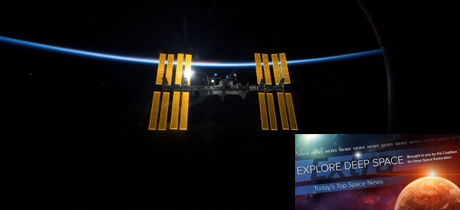In Today’s Deep Space Extra… The White House plans for NASA to resume human deep space exploration have sparked a discussion over the future of the International Space Station and whether its operation could transition to the commercial sector. NASA postpones a Monday spacewalk outside the International Space Station. Arianespace launches an inquiry into last week’s troubled Ariane 5 rocket launch.
Human Space Exploration
Potential end of the ISS raises concerns, presents opportunities
Space News (1/26): The future of the U.S. led International Space Station appears a likely topic of discussion as the Trump Administration’s 2019 fiscal year budget proposal moves to the U.S. Congress within weeks. The NASA Transition Act of 2017 called on the space agency to submit a blue print for transition out of its low Earth orbit activities and handing them off to the commercial sector as last year came to a close. The transition plan has not been disclosed, but the current end of space station activities is planned for 2024. President Trump has called for a U.S. return to the moon with human explorers.
How NASA plans to send humans back to the moon
National Geographic (1/26): During Pacific Ocean sea trials last week, NASA and the U.S. Navy demonstrated recovery operations for the Orion crew capsule that is to start NASA astronauts on future missions of deep space exploration.
Software patch fixes Space Station robot arm; Monday spacewalk repair called off
Spaceflightnow.com/CBS News (1/28): NASA has postponed a scheduled Monday spacewalk by International Space Station astronauts Mark Vande Hei, of NASA, and Norishige Kanai, of the Japan Aerospace Exploration Agency. Under a plan revised on Friday, they were to replace a new latching end effector, or LEE, on the Space Station’s Canadian robot arm that was installed by Vande Hei and fellow NASA space walker Scott Tingle on January 23. After last week’s spacewalk, it was determined the new LEE lacked command link redundancy. On Sunday, NASA and the Canadian Space Agency announced the redundancy issue could be remedied with a software fix. Currently, the two astronauts are to spacewalk in mid-February to retrieve one old LEE so that it can be returned to Earth and to re-stow a second old LEE outside the Space Station.
Space Science
Jupiter moon Europa’s possibly porous surface could doom a lander
Space.com (1/26): Europa, is an ice and ocean covered moon of Jupiter’s that may host habitable environments. The prospect is behind a new NASA mission, the Europa Clipper, that would make multiple close flybys of Europa while orbiting the large planet. However, a lab study at Tucson’s Planetary Science Institute suggests efforts to land on Europa by subsequent missions might encounter a “quick sand” like surface that would dash the mission.
Is this shiny satellite sky art or ‘space graffiti’?
New York Times (1/28): Rocket Labs is defending its decision to include a reflective sphere as a payload on the first successful launch of the Electron rocket developed specifically to accommodate small satellites as the primary payload. The launch occurred on January 21, placing a shiny carbon fiber orb known as the Humanity Star in orbit. Some astronomers, however, have characterized the sphere as pollution.
Other News
Satellites placed into incorrect orbits by Ariane 5 can be recovered, owners say
Space News (1/26): Operators of two communications satellites launched atop an Ariane 5 rocket from French Guiana late January 25 say their travels to geosynchronous Earth orbit and operations will continue despite post launch malfunctions. One of the satellites, the SES-14, hosts a pioneering NASA science ride share, the Global-scale Observations of the Limb and Disk remote sensing instrument, or GOLD. Because they were not placed in the correct orbit, the SES-14 and Al Yah 3 will take longer than intended to achieve operational status.
Arianspace launches inquiry into Ariane 5 anomaly
Spacepolicyonline.com (1/27): Launch services provider Arianespace has pledged an independent investigation into the January 25 Ariane 5 launch anomaly following lift off from French Guiana. As part of its partnership with NASA and the Canadian Space Agency in the development of the $8.8 billion James Webb Space Telescope, the European Space Agency is to contribute an Ariane 5 launch planned for 2019.
SpaceX aiming for first Falcon Heavy launch on February 6
Los Angeles Times (1/27): SpaceX on Saturday announced it plans the much anticipated inaugural launch of the company’s Falcon Heavy rocket from NASA’s Kennedy Space Center on February 6.
Russia’s Proton rocket falls on hard times
Ars Technica (1/26): Economic difficulties, fading quality control and international tensions have contributed to a decline for the Soviet era Proton rocket and its ability to compete in the global launch services market. After achieving a dozen launches in 2010, the Proton may fly just a couple of times this year.
Amateur astronomer discovers a revived NASA satellite
Science (1/26): Amateur astronomer Scott Tilley is being credited with the re-discovery of a NASA satellite called IMAGE that was launched in 2000 to study the Earth’s magnetosphere and declared dead five years later. Tilley’s find, prompted by his search for the recently launched mysterious Zuma satellite, has turned up IMAGE and the possibility it is now functioning.
Major Space Related Activities for the Week
Major space related activities for the week of January, 29 to February, 2, 2018
Spacepolicyonline.com (1/28): The space community is in the midst of marking the anniversaries of three tragedies, the February 1, 2003, January 28, 1986 and January 27, 1967 losses of the shuttle Columbia and Challenger crews as well as the Apollo 1 fire casualties. The non-profit Center for the Advancement in Science in Space (CASIS) hosts a public meeting Tuesday to discuss the research activities it manages within the U.S. National Lab volume of the International Space Station. Wednesday marks the anniversary of the first U.S. satellite launch, Explorer 1, which explored the Earth’s Van Allen belts. President Trump delivers his first State of the Union address to Congress on Tuesday.

